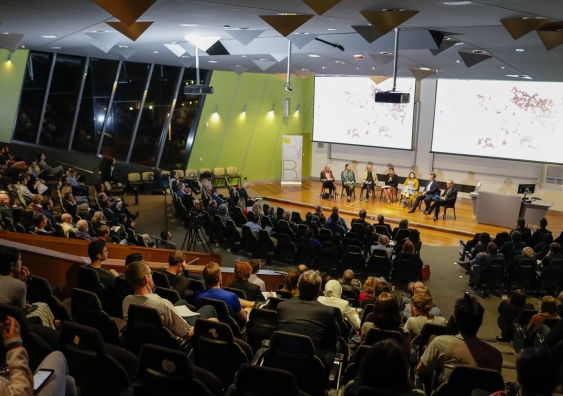First Faculty Showcase highlights Built Environment’s finest work
UNSW Built Environment’s best minds are seeking solutions to the biggest challenges facing our increasingly urbanised world.
UNSW Built Environment’s best minds are seeking solutions to the biggest challenges facing our increasingly urbanised world.

The Built Environment Showcase last week highlighted the critically important work being done by students, researchers, teaching staff and alumni. The Faculty held a series of events for an audience including UNSW President and Vice-Chancellor Professor Ian Jacobs, the University management board and executive staff, key industry supporters, teachers and students.
Hosted by the Dean of Built Environment, Professor Helen Lochhead, the Showcase featured some of the ground-breaking research, ideas and technology developed in line with the University’s 2025 strategic priorities – academic excellence, social engagement and global impact.
Australia is one of the most urbanised societies in the world and some of our biggest challenges are exacerbated in our cities by the growing spatial divide between the haves and the have-nots, housing affordability, and climate change, says Professor Lochhead.
"I want people to take away from the Showcase that complex urban issues are front and centre in our imagination and that we really need to focus on them through innovative and interdisciplinary approaches," she says.
"We believe in changing the world through positive engagement in these pressing urban challenges."
In the City Futures Research Centre, Associate Professor Hazel Easthope and Dr Laurence Troy revealed living conditions and construction problems in Sydney’s old apartment blocks and the desperate problems faced by some residents in strata-title properties.
Professor Susan Thompson spoke about the importance of building healthier cities and why good public design is crucial to creating strong communities and mitigating chronic disease, while PhD student Sian Thompson talked about the positive results that come from apartment residents getting to know their neighbours.

Professor Chris Pettit released the latest results from his City Analytics team, including cutting-edge research from the Rapid Analytics Interactive Scenario Explorer (RAISE) tool. This spatial data tool, which allows users to estimate and visualise property values, can predict the price impact of various infrastructure options to better focus infrastructure investment.
On the University’s Red Centre forecourt, Professor of High Performance Architecture Mat Santamouris demonstrated the capabilities of his team’s Energy Bus and their work mitigating urban heat islands, particularly in Darwin.
In the Liveability Lab, Associate Professor Catherine Bridge spoke passionately about her team’s research and the technology behind the devices that will help older Australians remain self-sufficient in their own homes for longer.
To showcase the Faculty’s global impact activities, Professor James Weirick explained the many benefits of students undertaking international study tours and design challenges; Professor David Sanderson asked whose reality counts when disadvantaged communities face urban disasters; and Dr Laura Crommelin questioned the impact of online property marketplace Airbnb’s operations in Phoenix, London and Sydney, on housing affordability
The Showcase concluded with a dose of social engagement – the Cities@UNSW panel discussion chaired by Professor Lochhead on the implications of spatial inequality in Sydney that revealed the growing divide between the haves and the have-nots.
The Showcase concept was devised by Professor Jacobs to present each faculty’s achievements to the University leadership, other academics and industry partners.
“It’s about giving everyone a chance to pause and reflect on what they have done,” he says.
“This is purely about celebration, achievements, encouragement and enthusiasm.
“Everything I’ve heard today is about what an impact this faculty can make. It is what a great university does.”
Built Environment was the first faculty to hold a Showcase event, with other faculties to follow in November and early 2018.